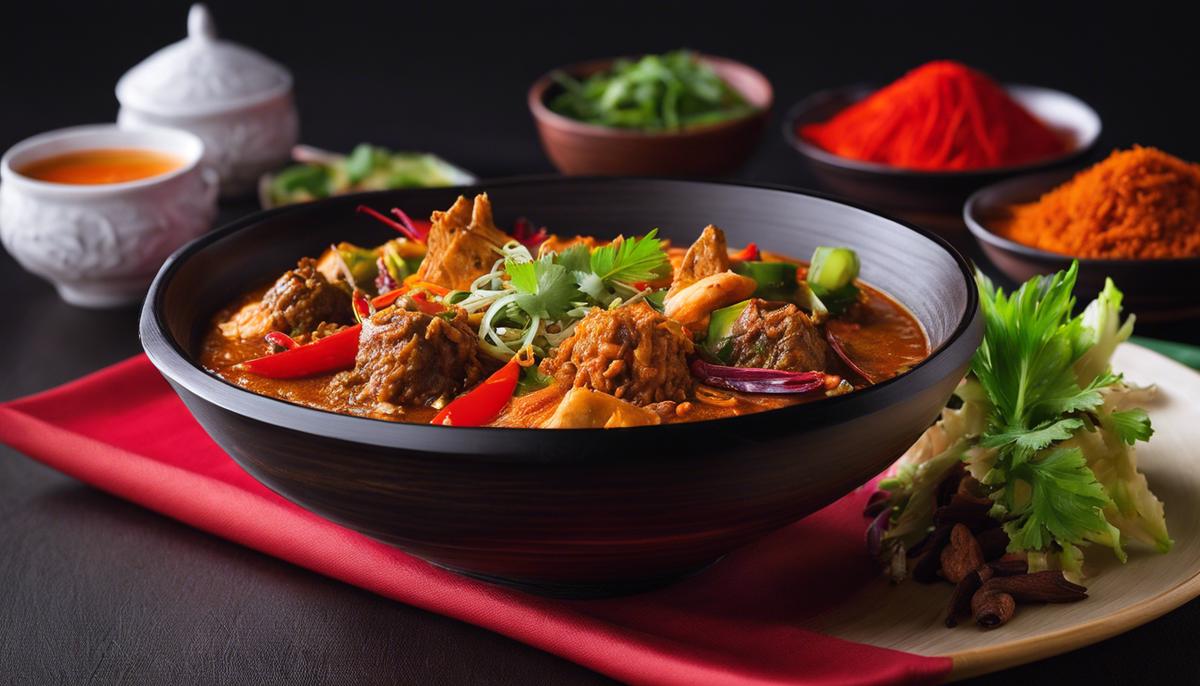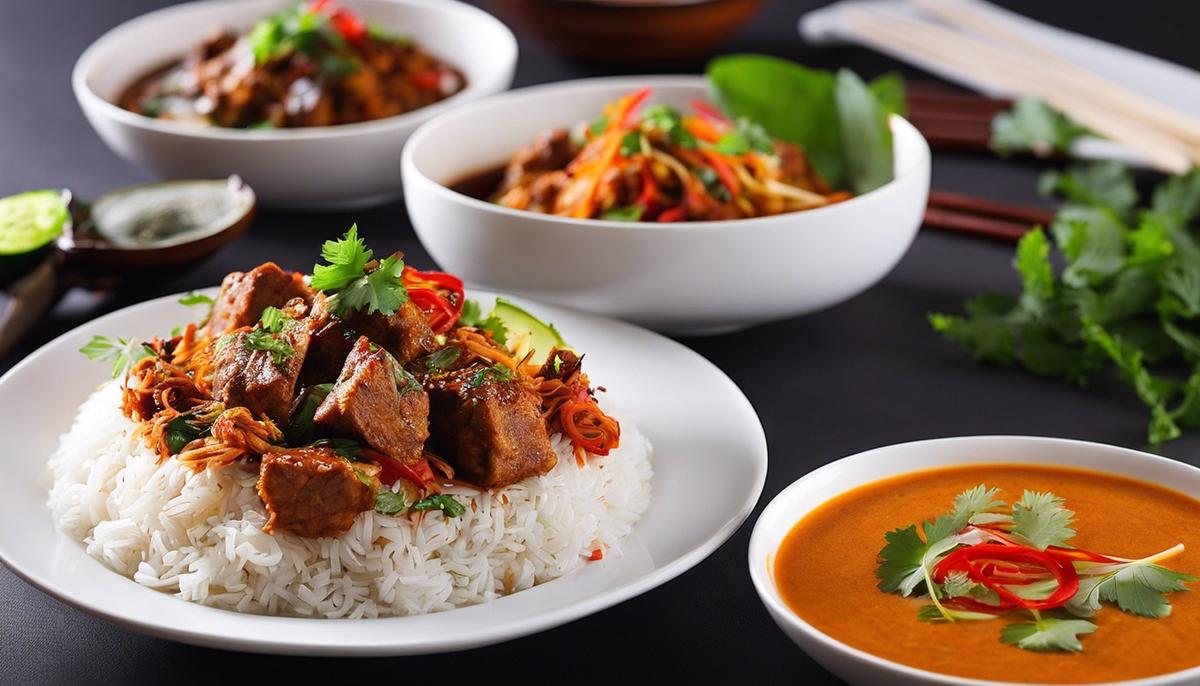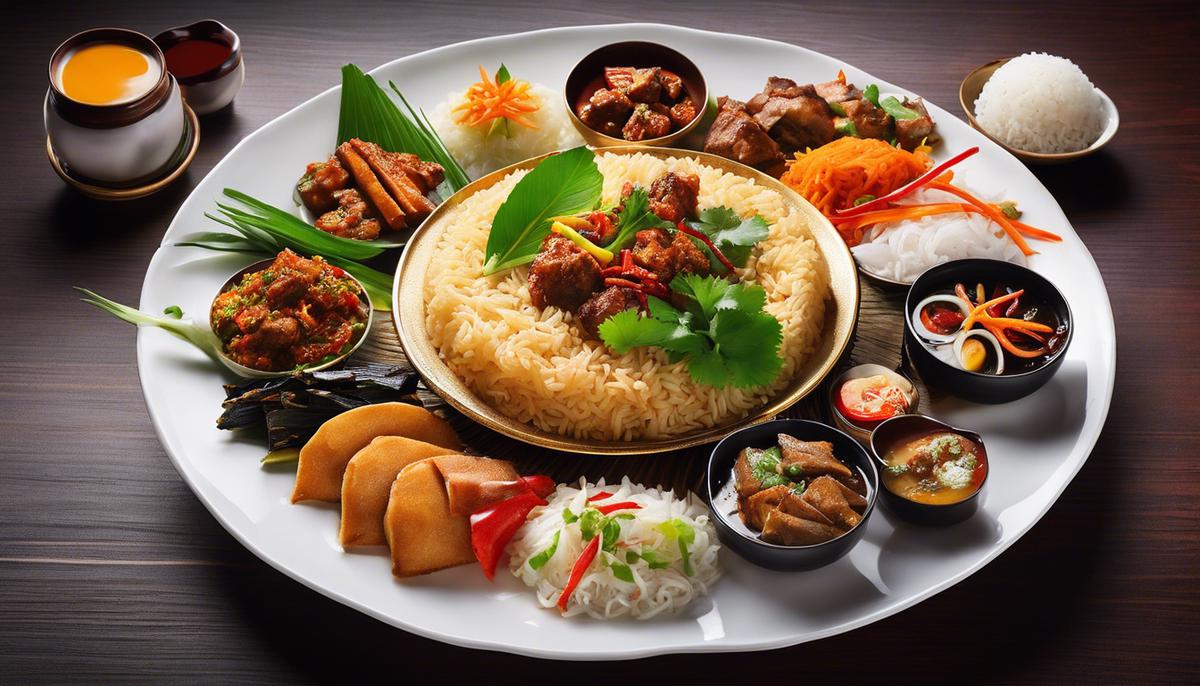The delightful mingling of aromatic spices, fresh produce, and succulent meats characteristic of Indo Chinese cuisine captures an intriguing tale of cultural assimilation and culinary innovation. With its roots deeply entrenched in the heart of Kolkata, Indo Chinese cuisine demonstrates an elegant dance of Indian and Chinese flavors, creating a gastronomical experience that delights the senses while simultaneously feeding the soul. This cuisine has not just redefined the concept of fusion food, but also serves as a testament to the harmonious coexistence of two distinct cultures. In this exploration, we will embark on a tantalizing journey, delving into the past, understanding the ingredients, discovering signature dishes, and acknowledging the cultural significance of this beloved cuisine. We shall also take a turn towards the modern adaptations that give a healthy twist to these traditional dishes.
The Origin and Evolution of Indo Chinese Cuisine
A Stirring Tale of Spice and Fusion: The Evolution of Indo-Chinese Cuisine
Passionate chefs and ardent foodies around the globe relish the magic of food and appreciate the culinary diversity it offers. Diving into this epic storehouse of flavors and aromas, one culinary journey that captures the imagination is the evolution of Indo-Chinese cuisine; an ethereal fusion crafted by tossing Chinese ingredients with quintessential Indian spices. Over the years, it’s become a distinct entity, adored by masses and cherished in dainty restaurants around the world.
Emerging from the melting pot of Kolkata in the late 18th century, Indo-Chinese cuisine began its journey in the hands of Hakka Chinese immigrants. Establishing successful eateries, they began serving their traditional cuisine, only to adapt and tweak it as per local Indian taste buds. Indo-Chinese cuisine was born when Sino staples met Indian heartiness, creating dishes that were intensely flavorful and utterly satisfying.
An emblematic dish of this cuisine is “Chilli Chicken,” a divine amalgamation of carefully tossed crispy chicken with a fiery mix of Indian spices and soy sauce, epitomizing this perfect fusion. Over time, contemporary chefs have added their stamp, transforming this dish into light, stir-fried versions, preserving the robust flavors while responding to the growing trend of health-conscious eating.
An equally popular example is “Hakka Noodles,” originally a basic noodle stir fry with veggies, which over the years, morphed into eclectic versions featuring a variety of proteins and a burst of Indian spices. Today, the savory dish is truly an incarnation of the gastronomic affair, a triumph of adaptation and improvisation.
The intriguing story of “Manchurian,” though, takes the spotlight in this flavored saga. Born entirely out of the inventive spirit of blending Chinese cooking techniques with Indian ingredients, Manchurian dishes are not found in traditional Chinese culture. They are the brainchild of Indo-Chinese innovation and have emerged as a global sensation from this unique culinary niche.
The evolution of Indo-Chinese cuisine has been marked by continuous tweakings, refinements, and recreations, standing as an embodiment of the dynamic nature of food. The cuisine has paved its way into elegant dining spaces and modest roadside stalls alike, becoming a gastronomic sensation that transcends all divides.
The tale of Indo-Chinese cuisine imparts a beautiful message – food taps into our commonality, spinning stories of culture, tradition, and evolution, and interweaving them into delectable and aromatic experiences that we can relish and share. It’s a testament to the inherent joy of trying something new, creating a hybrid taste that races across continents and directly into the hearts and palates of food enthusiasts far and wide.
The captivating journey of Indo-Chinese cuisine echoes that sentiment – food, rightfully so, is the ultimate connector, making us walk to the ends of the earth, carrying the essence of every flavor encountered, and creating something magical out of it.

The Signature Dishes of Indo Chinese Cuisine
Broadening Horizons: Unearth the Unseen Recipes of Indo Chinese Cuisine
A culinary playground of spices, flavors, sights, and smells. Close your eyes and imagine an irresistible fusion of tantalizing Szechuan sauce imbued with the warmth of traditional Indian tikka—a lavish rush of flavors across your palate that makes your taste buds dance. This is the mesmerizing world of Indo Chinese cuisine, but our culinary journey is just beginning.
Take a bow, Hot Garlic Sauce! If you’re one to chase a fiery kick on your plate, the Indo Chinese Hot Garlic Sauce is a must-try. A burst of heat beautifully tempered with tangy notes, it lathers more dishes than you can count — from sautéd chicken to pan seared paneer and stir-fried vegetables. While garlic is the undisputed hero in this robust sauce, the starring support cast of soy, vinegar, and Indian-spiced chili makes it a chart-topping hit in the fusion play list.
Right around the bend is the sizzling signature dish of Indo Chinese cuisine, Szechuan Fried Rice. Infused with the bold flavors of garlic, ginger, and scallions, it’s a symphony of textures — the crunch of finely diced vegetables intermingling with tender grains of rice, all wrapped in an exhilarating sizzle of Szechuan spice. So versatile, it can be enjoyed as a meal by itself or paired with an assortment of tantalizing gravies.
Fancy a soup for your soul? Look no further than Sweet Corn Soup. This one-pot wonder brims with the delicate sweetness of corn kernels swimming in a rich and silken broth, delicately seasoned with the characteristic Indo Chinese pungency. The addition of finely chopped vegetables not only adds a vibrant pop of color to this visually appealing dish but also a delightful crunch that enriches the entire dining experience.
For a breathtaking curtain closer, we introduce Gulab-Jamun with Ice-cream, an Indo Chinese dessert that has food enthusiasts swooning worldwide. A playful fusion of hot and cold, traditional and modern, Indian and Western. Imagine a sweet, thickened milk ball soaked in a warm sugar syrup paired with a scoop of your favorite ice cream. The stark contrast of flavors and temperatures is what makes this dessert an unrivaled sensation!
Indo Chinese cuisine is not just a culinary sub-genre that’s lip-smackingly good. It’s a testament to the harmonious coexistence of cultures and a candid portrayal of shared heritage. It goes to show that food is the one true universal language that binds us all together, fanning the flames of unity in diversity. Through every voyage into a new taste, we don’t merely satiate our appetites; instead, we enrich our understanding of the world and those who inhabit it. Dive into this irresistible culinary journey, and remember, sharing is caring!

Key Ingredients in Indo Chinese Food
While we’ve already touched on the Indo-Chinese cuisine, the magic truly lies within the nitty gritty: the ingredients. Many purveyors of this fusion food consider this unique blend of ingredients as the beating heart of these recipes. So what is it that adds life to these dishes?
At the core are the amalgamation of distinct sauces, the warmth of Indian spices, and the heritage of Chinese cooking techniques. These are the elements that continue to keep the spirit of Indo-Chinese cuisine alive and flourishing.
Chinese ingredients like soy sauce, vinegar, and corn starch, for starters, are a constant. These staple elements lend a deep, rounded flavor and the slippery, glossy finish we associate with Chinese cuisine. They serve as the blank canvas upon which the more complex layers of flavor are built.
Then there is the iconic ‘Indian touch’. Ingredients like green chillies, red chilli flakes, ginger, and most unmistakably, curry leaves, are embraced warmly in the Indo-Chinese kitchen. While these may not be traditionally Chinese, their inclusion is a testament to the fusion cooking technique, creating dishes with a kick of spice that would salsa dance on the tongue of any heat-seeking food lover.
Another heavyweight in this flavor match made in heaven is Ajinomoto, also known as MSG. Despite its controversial status, there is no denying the unparalleled umami it brings to the plate. Paired with the Indian habit of adding ghee to their dishes, it results in a blissfully luscious gravy that keeps you reaching for more.
And let’s not forget the tenderizing power of cornstarch. Trusted by both Indian and Chinese cuisines, it creates the melt-in-your-mouth texture we insist on in any respectable Manchurian.
Part of the intrigue of Indo-Chinese food is in the staples. Certain dishes like Szechuan Fried Rice and Hot and Sour Soup owe their addictive quality to the magic of component ingredients. Whole grains of jasmine rice are tossed with fiery Szechuan sauce and freshly chopped veggies; while a bowl of Hot and Sour Soup features the tartness of vinegar contrasted with a spice combo that doesn’t just warm the tongue, but lights a little fire that’s oh-so pleasing to the palate.
If one has developed a sweet fang for Indo-Chinese cuisine, dessert options are not lacking. Imagine this – the warm, syrupy sweetness of a top-notch Gulab Jamun sitting alongside a scoop of icy vanilla ice-cream. Much like the cuisine itself, this combination brings two different worlds together, creating a symphony of flavors that is complicated, surprising, but oh-so delightful!
So, exploring the landscape of Indo-Chinese cuisine and the intricate interplay of ingredients is not just tasting food, it’s about experiencing a tantalizing fusion of flavors. It’s a journey across continents and cultures, all from the comfort of your own kitchen. From the humble fusion food stalls in Kolkata to global cuisine stages, it continues to satiate those of us with adventurous palates and unites us in our shared love for this culinary artistry.

The Cultural Impact of Indo Chinese Cuisine
The amplification of Indo-Chinese culinary techniques to the world
Indo-Chinese cuisine holds a special place in not just the culinary world but also in the hearts of those adventurous food lovers who are always on the quest for new flavors. A testament to the transformative power of cultural exchange, Indo-Chinese cuisine is an impactful narrative of culinary evolution and innovation.
One of the most significant aspects of Indo-Chinese cuisine is its exciting blend of cooking techniques. Chinese cooking methods such as stir-frying, deep-frying, and steaming are married with Indian culinary processes like roasting and tandoor grilling. This symbiosis of cooking styles culminates into dishes that are as magical as the alchemy that created them.
No discussion about Indo-Chinese cuisine’s influence would be complete without mentioning the ‘Chindian’ restaurants that dot the globe. From neighborhood joints to high-end eateries, they’ve successfully brought the cuisine’s richness and vibrancy to a global audience. These gastronomical powerhouses serve as a cultural and culinary bridge, bringing together food enthusiasts of different palates.
Beyond just tantalizing our taste senses, Indo-Chinese cuisine has sparked a conversation about the exciting possibilities of fusion food. This fusion genre isn’t limited to merely blending recipes but extends to merging of cooking methods and food presentation techniques. Definition of a true cultural exchange, these dishes bring unfamiliar ingredients into domestic cooking styles forging a connection between diverse cultures.
Influence of this fusion cuisine isn’t confined to restaurants and professional kitchens alone. Today, many homes across the world are spicing up the wok with Indian masalas, either following authentic Indo-Chinese recipes or experimenting with their own versions. In these humble initiatives, we find the real impact of cultural exchanges – bonds formed around dinner tables that surpass geographical borders.
Indo-Chinese cuisine has also carved a niche for itself in the realm of street food. Think of Mumbai’s bustling Khau Gallis or New York’s vibrant food trucks, where aroma of Szechuan sauce mingling with Indian spices becomes an irresistible invitation to savor a plate of hot and spicy Indo-Chinese dish.
Above all else, Indo-Chinese cuisine sets the reminder that food is more than just a sensory pleasure, it is a testament to our shared humanity. It narrates a tale of unity and harmony, while making the world realize that diversity can indeed blend beautifully.
From Manchuria to Mumbai and beyond, Indo-Chinese food is that delicious paradox that both represents and unifies our assorted tastes. Through it, we see that the power of culinary fusion stretches far beyond the kitchen. It stands as a testament to the fact that when cultures blend, the result is nothing short of extraordinary.

Healthy Twists to Traditional Indo Chinese Dishes
Now that we’ve taken a look at the signature and vibrant flavors of Indo-Chinese cuisine, it’s time to delve into the act of transforming these traditional dishes into healthier, yet equally tantalizing versions. A beautiful culinary tradition like this warrants preservation but could also use a bit of reinvention to cater to our ever-evolving health needs.
Let’s turn our attention towards the key to any Indo-Chinese dish; the spices, herbs, and seasonings. Consider swapping a portion of the salt with spices and herbs like black pepper, coriander, turmeric, and garlic for a lesser sodium intake. Opt for fresh, local herbs like cilantro, chili peppers, and ginger, because these not only add a kick of flavor but are also known for their powerful antioxidant properties.
Next up are those piquant sauces that give Indo Chinese dishes their remarkable flavour. It’s a well-known fact that most commercial sauces contain added sugars and preservatives. A healthier alternative? Try making them at home! From fiery Schezwan to sweet and spicy Manchurian, homemade sauces allow for control over the amount of sugar and sodium, making for a healthier delicacy without letting go of the taste.
In this journey of healthy transitioning, don’t overlook the base component; the rice and noodles. White rice and noodles are rich in carbohydrates but lack fiber. Switching to brown rice or whole grain noodles can diversify the nutritional value of the dish, without changing the core texture and flavor. Not to forget, they’re rich in dietary fiber and can keep you sated for longer, aiding in weight control.
While Indo-Chinese cuisine is famous for its deep-fried, crunchy delights, an easy way to cut back on those extra calories is by altering the cooking method. Steaming, grilling, or stir-frying can be ideal substitutes for deep frying. These methods require less oil, yet manage to render that required crunchiness and taste, courtesy of the rapid, high-heat cooking.
The essence of any dish lies in the protein, and Indo-Chinese cuisine is often rife with varieties of succulent meats. However, for a healthier twist, tofu or a medley of colorful vegetables can be great alternatives. This not only makes the dish lighter but also increases its nutritive value.
Lastly, who can forget the culmination point of any meal, the dessert? Reducing the quantity of added sugars and fats in favor of natural sweeteners like honey or dates can make your Gulab Jamun a guilt-free indulgence. Additionally, using skimmed milk or yogurt can offer the required creaminess and consistency in place of full-fat dairy.
Embarking on this journey of health-centric transformation, it’s crucial to remember that the aim is not to replace the authenticity of Indo-Chinese cuisine but rather to modify it in ways that serve our health needs while gratifying our palates.
Sometimes, it’s the small changes that make a big difference, and when it comes to food, these differences also promise flavors that surprise, delight, and nourish. With these tweaks, the table is set for you to enjoy your favorite Indo-Chinese dishes in a healthier, tastier form. Happy cooking… and eating!

From the bustling streets of Kolkata to high-end restaurants worldwide, the journey of Indo Chinese cuisine is a tribute to culinary blending and cultural osmosis. Amid all the delectable dishes and unique flavors, lie reflections of shared histories, common human experiences, and the powerful language of food that effortlessly bridges gaps between cultures. Unveiling healthier spins on these traditional dishes, proves that the evolution of Indo Chinese cuisine is far from over. It continues to adapt and evolve, symbolizing that fusion in food, just like in life, can lead to more enriching experiences, simultaneously comforting us with treasures from the past and guiding us towards a merrier, healthier future.
